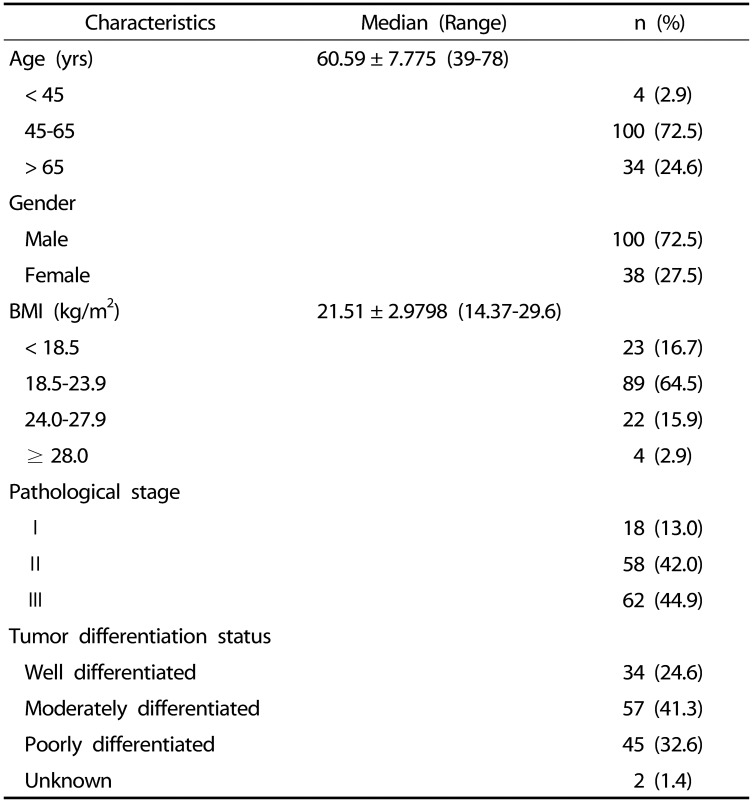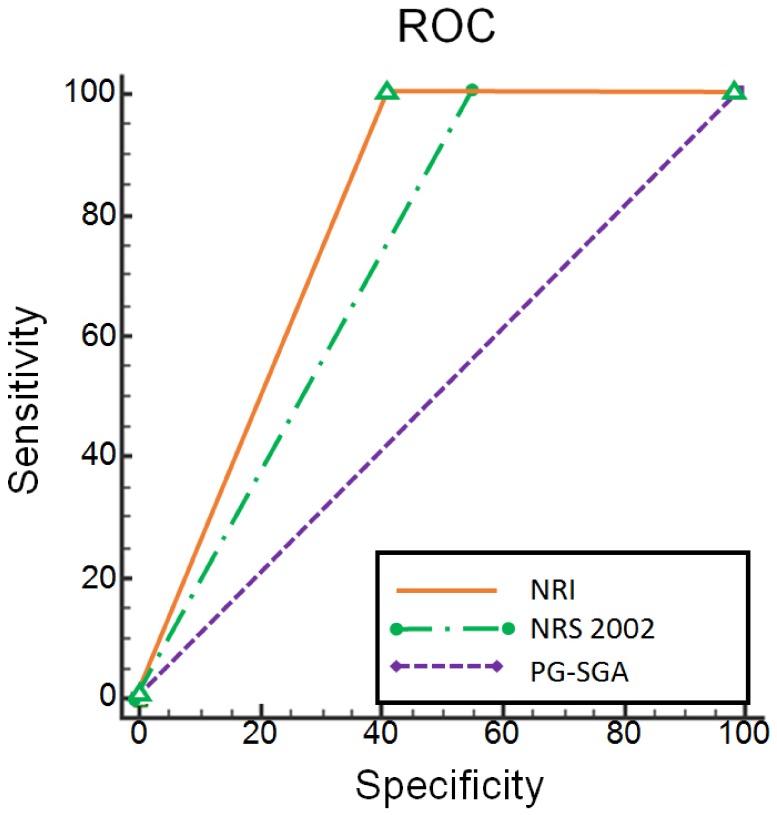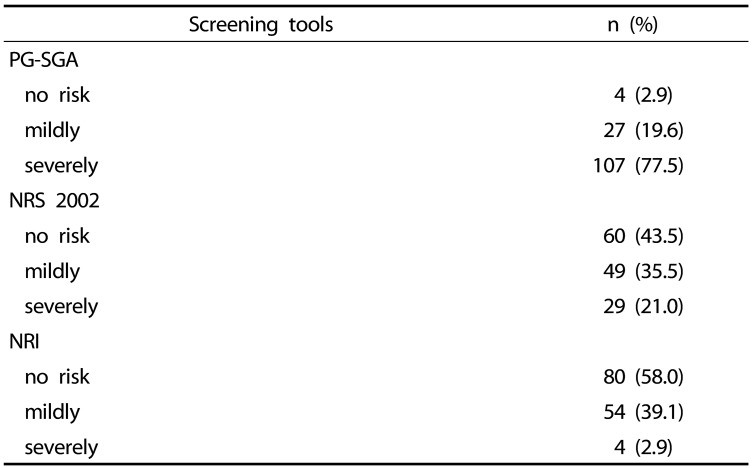1. Xu W, Liu Z, Bao Q, Qian Z. Viruses, other pathogenic microorganisms and esophageal cancer. Gastrointest Tumors. 2015; 2:2–13. PMID:
26674173.

2. Gupta R, Ihmaidat H. Nutritional effects of oesophageal, gastric and pancreatic carcinoma. Eur J Surg Oncol. 2003; 29:634–643. PMID:
14511609.

3. Miller KR, Bozeman MC. Nutrition therapy issues in esophageal cancer. Curr Gastroenterol Rep. 2012; 14:356–366. PMID:
22730015.

4. Sun Z, Cao Z, Ye Q, Liang E, Fu H, Qian X. Preoperative NRS 2002 assessment of nutritional risk of patients with esophagus cancer and postoperative results. Chin J Clin Thorac Cardiovasc Surg. 2015; 22:323–326.
5. Li Y, Cheng Y, Xu B, Duan X, Xu J, Qi D. The effective of nutrition risk assessment and interventions in patients with esophageal cancer. Chung Hua Hu Li Tsa Chih. 2015; 50:166–170.
6. Wischmeyer PE, Carli F, Evans DC, Guilbert S, Kozar R, Pryor A, Thiele RH, Everett S, Grocott M, Gan TJ, Shaw AD, Thacker JK, Miller TE, Hedrick TL, McEvoy MD, Mythen MG, Bergamaschi R, Gupta R, Holubar SD, Senagore AJ, Abola RE, Bennett-Guerrero E, Kent ML, Feldman LS, Fiore JF Jr. Perioperative Quality Initiative (POQI) 2 Workgroup. American society for enhanced recovery and perioperative quality initiative joint consensus statement on nutrition screening and therapy within a surgical enhanced recovery pathway. Anesth Analg. 2018; 126:1883–1895. PMID:
29369092.

7. Hu CL, Yu M, Yuan KT, Yu HL, Shi YY, Yang JJ, Li W, Jiang HP, Li ZN, Xu HX, Ba Y, Wang KH, Li SY, Shi HP. Determinants and nutritional assessment value of hand grip strength in patients hospitalized with cancer. Asia Pac J Clin Nutr. 2018; 27:777–784. PMID:
30045421.
8. Kondrup J, Rasmussen HH, Hamberg O, Stanga Z. Ad Hoc ESPEN Working Group. Nutritional risk screening (NRS 2002): a new method based on an analysis of controlled clinical trials. Clin Nutr. 2003; 22:321–336. PMID:
12765673.

9. Oh CA, Kim DH, Oh SJ, Choi MG, Noh JH, Sohn TS, Bae JM, Kim S. Nutritional risk index as a predictor of postoperative wound complications after gastrectomy. World J Gastroenterol. 2012; 18:673–678. PMID:
22363139.

10. Robinson MK, Trujillo EB, Mogensen KM, Rounds J, McManus K, Jacobs DO. Improving nutritional screening of hospitalized patients: the role of prealbumin. JPEN J Parenter Enteral Nutr. 2003; 27:389–395. PMID:
14621119.

11. Makhija S, Baker J. The Subjective Global Assessment: a review of its use in clinical practice. Nutr Clin Pract. 2008; 23:405–409. PMID:
18682592.

12. Bauer J, Capra S, Ferguson M. Use of the scored Patient-Generated Subjective Global Assessment (PG-SGA) as a nutrition assessment tool in patients with cancer. Eur J Clin Nutr. 2002; 56:779–785. PMID:
12122555.

13. Rasmussen HH, Kondrup J, Ladefoged K, Staun M. Clinical nutrition in danish hospitals: a questionnaire-based investigation among doctors and nurses. Clin Nutr. 1999; 18:153–158. PMID:
10451472.
14. Kondrup J, Rasmussen HH, Hamberg O, Stanga Z. Ad Hoc ESPEN Working Group. Nutritional risk screening (NRS 2002): a new method based on an analysis of controlled clinical trials. Clin Nutr. 2003; 22:321–336. PMID:
12765673.

15. Chinese Medical Association. Nutrition support guidelines for clinical diagnosis and treatment. Beijing: People's medical Publishing House Co.;2009. p. 8–9.
16. Chen W, Jiang Z, Zhang Y, Wang X, Chen C, Shi Y. Evaluation of European nutrition risk screening method in Chinese hospitalized patients practice. Chin J Clin Nutr. 2005; 13:137–141.
17. Kondrup J, Allison SP, Elia M, Vellas B, Plauth M. Educational and Clinical Practice Committee. European Society of Parenteral and Enteral Nutrition (ESPEN). ESPEN guidelines for nutrition screening 2002. Clin Nutr. 2003; 22:415–421. PMID:
12880610.

18. McClave SA, Taylor BE, Martindale RG, Warren MM, Johnson DR, Braunschweig C, McCarthy MS, Davanos E, Rice TW, Cresci GA, Gervasio JM, Sacks GS, Roberts PR, Compher C. Society of Critical Care Medicine. American Society for Parenteral and Enteral Nutrition. Guidelines for the provision and assessment of nutrition support therapy in the adult critically ill patient: society of critical care medicine (SCCM) and American society for parenteral and enteral nutrition (A.S.P.E.N.). JPEN J Parenter Enteral Nutr. 2016; 40:159–211. PMID:
26773077.
19. Buzby GP, Knox LS, Crosby LO, Eisenberg JM, Haakenson CM, McNeal GE, Page CP, Peterson OL, Reinhardt GF, Williford WO. Study protocol: a randomized clinical trial of total parenteral nutrition in malnourished surgical patients. Am J Clin Nutr. 1988; 47:366–381. PMID:
3124598.

20. Buzby GP, Williford WO, Peterson OL, Crosby LO, Page CP, Reinhardt GF, Mullen JL. A randomized clinical trial of total parenteral nutrition in malnourished surgical patients: the rationale and impact of previous clinical trials and pilot study on protocol design. Am J Clin Nutr. 1988; 47:357–365. PMID:
3124597.

21. Hasselmann M, Alix E. Tools and procedures for screening for malnutrition and its associated in risks in hospital. Nutr Clin Metab. 2003; 17:218–226.
22. Meves V, Behrens A, Pohl J. Diagnostics and early diagnosis of esophageal cancer. Viszeralmedizin. 2015; 31:315–318. PMID:
26989385.

23. Reim D, Friess H. Feeding challenges in patients with esophageal and gastroesophageal cancers. Gastrointest Tumors. 2016; 2:166–177. PMID:
27403411.









 PDF
PDF ePub
ePub Citation
Citation Print
Print




 XML Download
XML Download